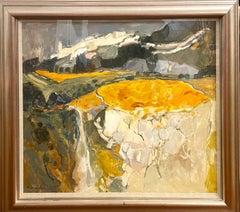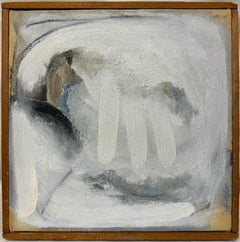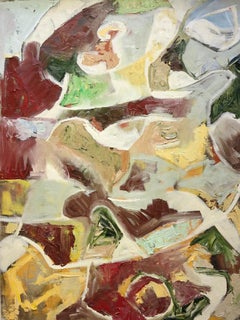Joseph Fiore Art
Joseph Albert Fiore ascended the ranks of Black Mountain College, first as a summer student, then full-time enrollee and later as one of the school’s longest-tenured professors. Throughout his nearly 60-year artistic career, Fiore experimented with a multitude of techniques from gestural brushwork, geometric shapes and amorphous forms. He never fully committed to any particular mode. Born in Cleveland, Ohio, Fiore belonged to a family that embraced the arts: his grandfather was an Italian architectural painter, and his father Salvatore played the violin for the Cleveland Orchestra. Studio classes at the Cleveland Museum of Art piqued his interest, but it was an article about an experimental liberal arts college in North Carolina, Black Mountain College, that prompted Fiore to pursue a formal art education. His conscription into the army during World War II delayed his matriculation, which finally took place in 1946. Fiore’s initial acceptance was limited to the college’s summer session, during which time he studied under director Josef Albers as well as Jacob Lawrence, whose use of color intrigued him. Under the auspices of the G.I. Bill, Fiore reapplied as a regular student and started classes that fall. He found himself drawn to Albers’ sabbatical replacement, Ilya Bolotowksy. The gregarious Russian émigré permitted greater creative autonomy than the more regimented Albers allowed and was quite popular with the student body. From 1948–49, Fiore attended the California School of Fine Art and later the San Francisco Art Institute, but returned to Asheville in the summer of 1949. He was appointed to the college’s faculty member that autumn, a position he would hold for the next seven years. Tragedy struck in 1953 when a fire destroyed most of Fiore’s belongings; as a result, few works made during the artist’s time at Black Mountain survive. After the college’s dissolution in 1957, Fiore and his wife, a former Black Mountain student, moved to New York. Through connections he had made in North Carolina, Fiore began exhibiting his work which included representational and abstract compositions, as well as collages to critical acclaim. He continued to teach, filling faculty posts at the Philadelphia College of Art and the Maryland College of Art. By the 1960s, Fiore’s style had shifted, and he started to produce semi-realistic landscape paintings. Writing about Fiore’s solo show at New York’ Staempfli Gallery in the November 5, 1960 edition of The Nation, noted critic Fairfield Porter praised the artist’s interpretations of “a fragment of Nature’s whole” which Porter said emphasized relationships over objects. Fiore’s new focus may have been inspired by the purchase of a summer house in Maine and his growing interest in environmental issues. In 1980, Fiore taught a summer program sponsored by Parsons School of Design at Les Eyzies in southwestern France. The Dordogne region is home to several prehistoric sites, and Fiore soon began to incorporate pictograms and petroglyphs into his paintings. He was honored with the National Academy of Design’s prestigious Andrew Carnegie Prize in 2001. His work can be found in the collections of the National Gallery of Art and the Whitney Museum of American art, among others. His commitment to conservation lives on through the Joseph A. Fiore Art Center at Rolling Hills Farm, a program of the Maine Farmland Trust which hosts art residencies and mounts exhibitions.
Mid-20th Century Abstract Expressionist Joseph Fiore Art
Canvas, Oil
Late 20th Century Abstract Expressionist Joseph Fiore Art
Canvas, Oil
1950s Abstract Expressionist Joseph Fiore Art
Canvas, Oil
1950s Abstract Expressionist Joseph Fiore Art
Canvas, Oil
1960s Abstract Expressionist Joseph Fiore Art
Canvas, Oil
1960s Abstract Expressionist Joseph Fiore Art
Canvas, Oil
1960s Abstract Expressionist Joseph Fiore Art
Canvas, Oil
1950s Abstract Expressionist Joseph Fiore Art
Canvas, Oil
1980s Abstract Expressionist Joseph Fiore Art
Canvas, Pastel, Mixed Media, Oil, Handmade Paper
1960s Abstract Expressionist Joseph Fiore Art
Canvas, Oil
1970s Abstract Expressionist Joseph Fiore Art
Canvas, Oil
2010s Abstract Expressionist Joseph Fiore Art
Canvas, Oil
21st Century and Contemporary Abstract Expressionist Joseph Fiore Art
Canvas, Oil Pastel, Oil, Spray Paint, Acrylic
Mid-20th Century Abstract Expressionist Joseph Fiore Art
Canvas, Oil
Joseph Fiore art for sale on 1stDibs.
Artists Similar to Joseph Fiore
- Who started Joseph?1 Answer1stDibs ExpertApril 5, 2022Joseph Ettedgui started the luxury fashion brand Joseph. He founded the company Joseph in 1972 in London, UK. Originally, Joseph served as a boutique for luxury fashions produced by other brands, but eventually began to manufacture and carry its own label. You'll find a collection of Joseph apparel on 1stDibs.
- 1stDibs ExpertJanuary 19, 2025Joseph Paxton was famous for his achievements in art and design. He was a talented Victorian garden designer and architect. For London’s Exposition of 1851, Paxton created the Crystal Palace, an immense iron and glass structure. It was a showcase of Victorian innovation and design and earned its creator a knighthood. Paxton also created his own Lily House at Chatsworth, where he displayed his prized water lilies. Explore a selection of fine art on 1stDibs.
- What is Joseph Stella known for?1 Answer1stDibs ExpertOctober 15, 2024Joseph Stella is known for his work as an artist. He was a visionary artist who painted what he saw: an idiosyncratic and individual experience of his time and place. Stella was 19 when he arrived in the United States and studied in the early years of the century at the Art Students League and with William Merritt Chase, under whose tutelage he received rigorous training as a draftsman. His love of line and his mastery of its techniques are apparent in his early illustrations for various social reform journals. Stella, whose later work as a colorist is breathtakingly lush, never felt obliged to choose between line and color. He drew throughout his career, and unlike other modernists, whose work evolved to more and more abstract forms, Stella freely reverted to earlier realist modes of representation whenever it suited him. Some of his most famous works include Battle of Lights, Coney Island, Mardi Gras; The Brooklyn Bridge: Variation on an Old Theme and Flowers, Italy. Shop a selection of Joseph Stella art on 1stDibs.
- 1stDibs ExpertAugust 29, 2024Opinions differ about what kind of artist Joseph Stella was. At various times, his work echoed the concerns and techniques of the so-called Ashcan School, New York Dada, Futurism and Cubism, among others. These are all legitimate influences, but Stella never totally committed himself to any group. Some people also associate him with the American Precisionist movement, which emerged after World War I and explored industrialization and urbanization themes. Shop a diverse assortment of Joseph Stella art on 1stDibs.
- 1stDibs ExpertAugust 29, 2024No, Frank Stella was not related to Joseph Stella. While it's possible that in-depth genealogical research may uncover a shared ancestor many generations ago, the two artists are not currently believed to be related. Joseph Stella was born in 1877 in Muro Lucano, Italy, while Frank Stella was born in 1936 in Malden, Massachusetts. On 1stDibs, shop a diverse assortment of Frank Stella and Joseph Stella art.
- 1stDibs ExpertAugust 29, 2024Joseph Stella first painted the Brooklyn Bridge in 1918. He actually returned to the subject numerous times, completing additional paintings of the landmark in 1918, 1920, 1939 and 1941. Examining these paintings side by side shows how Stella's style became more and more abstract over the course of his career. Explore an assortment of Joseph Stella art on 1stDibs.


